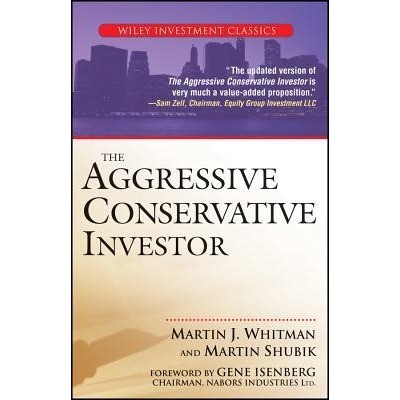Customer Reviews The Aggressive Conservative Investor (Wiley Investment Classics)
Post on: 1 Июнь, 2015 No Comment

This book accomplishes two quite different things, both of which should be of use to the committed investor. First of all, it sets forth an investment philosophy in great detail. Second, it shows investors how to analyze securities themselves. In both those respects, it is on a par with Securities Analysis by Graham and Dodd (also highly recommended — I have also reviewed that book), although it is a much easier read.
In setting forth an investment philosophy, the book compares well with Common Stocks and Uncommon Profits by Phil Fisher and The Intelligent Investor by Benjamen Graham (both recommended). Whereas Fisher emphasized growth companies and management analysis and Graham emphasized earnings, Whitman and Shubik emphasize low price/book ratios. They support their position quite ably with examples and. where available, studies.
The Aggressive Conservative Investor also contains a good bit of information about securities analysis. While it is not as in-depth as Security Analysis (the Graham and Dodd classic), the chapters on financial accounting and GAAP are a must read, particularly since the book convincingly demonstrates that the utility of financial statements will differ depending upon the position of the person reviewing them.
Whitman and Shubik are most certainly value investors who focus on analyzing a particular company (as compared to the market as a whole, interest rate trends, etc.), although they also cover asset conversion investing, which may involve investing in distressed companies. They make an excellent argument that, in many cases, companies with unencumbered assets may make excellent investments. They also freely take exception to accounting conventions that emphasize earnings, and they repeatedly demonstrate how earnings may be affected by accounting policies that are beyond the control (and arguably the understanding) of most investors, including me.
Another interesting thing about this book is that it covers different corporate constituancies (banks, bondholders, management, insurance companies, passive outside shareholders, etc.) and how their involvement affects and is affected by corporate activities in great detail. The book notes that even investors in common stock may have different objectives, and it discusses how these perspectives may affect the company over time.
The book also has an excellent discussion of sources of corporate disclosure, in order to take advantage of the company’s public communications to understand it better. While I am generally aware of many of these sources, the book does a commendable job of explaining them in greater detail.
The Aggressive Conservative Investor does contain some numeric analysis that may be hard to follow, and it can’t be called an easy read, although it certainly is not as hard to read as Security Analysis. Moreover, some of the information contained in the book is now outdated due to changes in the tax code. These are minor concerns to me, however, and I would highly recommend this book to anyone who is serious about investing.
Help other customers find the most helpful reviews
Was this review helpful to you? Yes No














